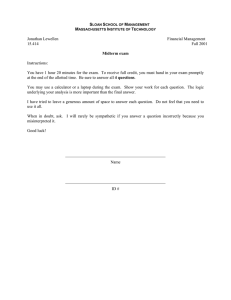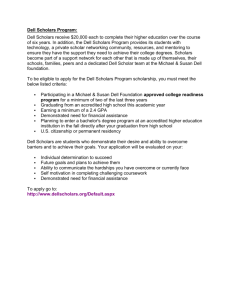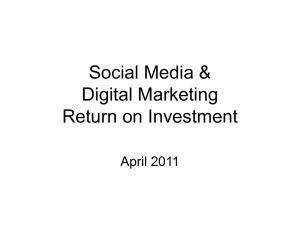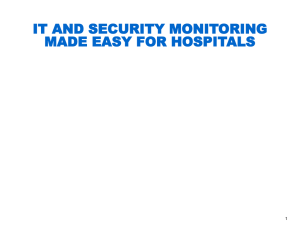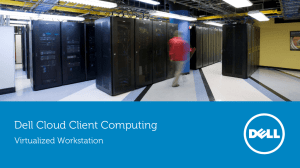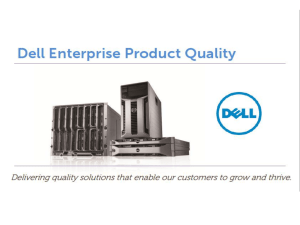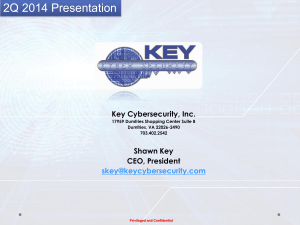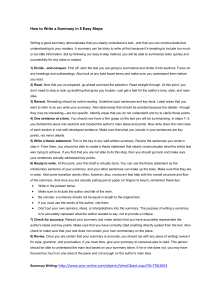sloan school of management massachusetts institute of technology
advertisement
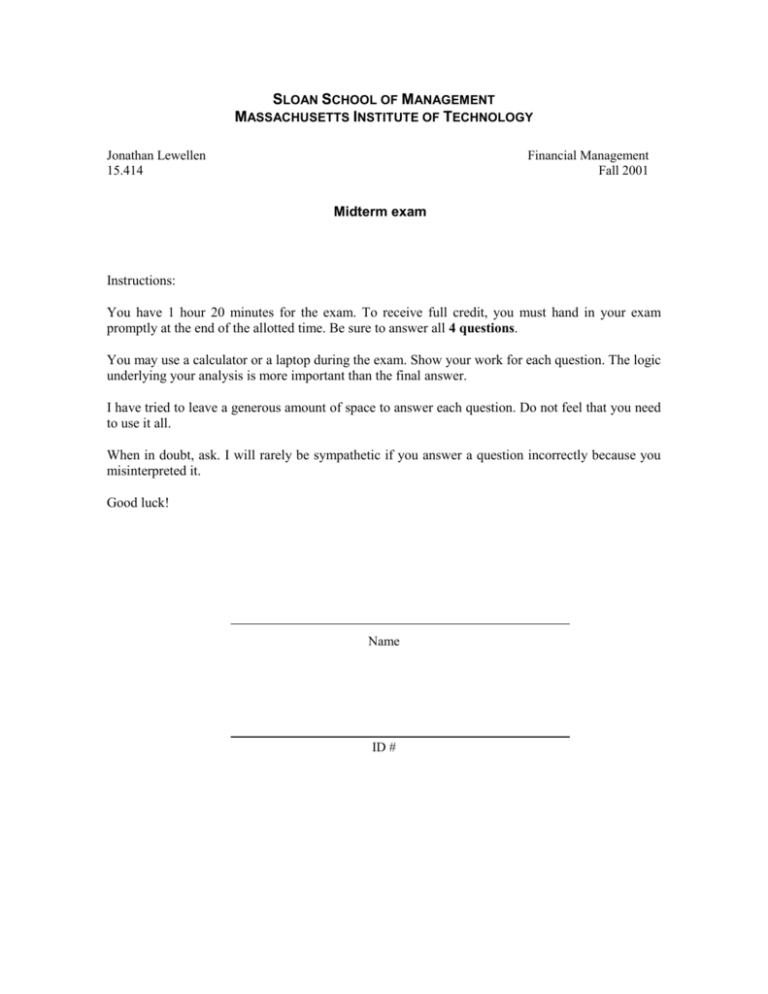
SLOAN SCHOOL OF MANAGEMENT MASSACHUSETTS INSTITUTE OF TECHNOLOGY Jonathan Lewellen 15.414 Financial Management Fall 2001 Midterm exam Instructions: You have 1 hour 20 minutes for the exam. To receive full credit, you must hand in your exam promptly at the end of the allotted time. Be sure to answer all 4 questions. You may use a calculator or a laptop during the exam. Show your work for each question. The logic underlying your analysis is more important than the final answer. I have tried to leave a generous amount of space to answer each question. Do not feel that you need to use it all. When in doubt, ask. I will rarely be sympathetic if you answer a question incorrectly because you misinterpreted it. Good luck! Name ID # 1. True or false? Briefly explain. (a) _____ You own a 10-year U.S. Treasury STRIP. You are certain that the government will repay the face value of the bond. Therefore, the investment is riskless. (b) _____ You own 1,000 call options on Intel stock with a strike price of $20. The options mature in April 2002. Intel’s current stock price is $26.10, but you are worried that the price may drop to $10 – $15 by April. If you are confident about this forecast, you should exercise the options now to lock in their value. (c) _____ Depreciation is an accounting expense, but does not represent a cash flow. Therefore, it is unimportant for capital budgeting decisions. 1 1. True or false, cont. (d) _____ Two bonds with the same time-to-maturity must also have the same duration. (e) _____ Last year, Boston Electronics earned $5 per share. Analysts forecast that EPS will grow 6% annually. Herb Chambers Auto Group also earned $5 per share, but analysts forecast that it will only grow 4% annually. If the market is efficient, Boston Electronics should have a higher stock price than Herb Chambers Auto Group. (f) _____ You are evaluating an investment in IBM stock. Since you plan to hold the stock for only one year, you do not have to worry about IBM’s long-term prospects 2 2. Your firm is evaluating an acquisition of Sealed Air Corp., a manufacturer of packaging material. As part of the analysis, you have collected the following information about Sealed Air: Projections($million) Year Current 2002 2003 2004 250.0 157.5 25.0 37.5 259.3 163.3 25.9 38.9 268.8 169.4 26.9 40.3 278.8 175.6 27.9 41.8 EBIT Taxes Interest 30.0 10.2 0 31.1 10.6 0 32.3 11.0 0 33.5 11.4 0 Net income 19.8 20.5 21.3 22.1 12.0 -187.0 12.5 45.4 194.0 12.9 47.0 201.1 13.4 48.8 208.6 Sales Cost of goods sold Selling and admin Depreciation Net working capital Capital expenditure Shareholders equity (a) Based on the projections, what is the value of Sealed Air? The cost of capital is 10%. 3 2. (b) What fraction of Sealed Air’s value comes from growth opportunities and what fraction comes from existing assets? 4 3. You work for Delta Airlines. Last year, revenues were $15 billion and costs were $14 billion. One of the biggest expenses for Delta is fuel costs, which totaled $2.5 billion last year. This costs represents 100 million barrels of oil consumed at an average price of $25 / barrel. (a) If revenues and other costs are constant, how does Delta’s net income change if the oil price drops to $20 or increases to $30? Graph Delta’s net income as a function of the oil price. (b) Delta would like to eliminate its exposure to oil price risk. How can it do this using futures? The future price of oil to be delivered next year is $22 / barrel. If Delta uses futures, graph its net income as a function of the oil price. 5 3. (c) How can Delta hedge its risk exposure using options? Be specific: Should it use call or put options? Buy or sell? What are the trade-offs of using options with a higher or lower strike price? If Delta uses options, graph its net income as a function of the oil price. (d) Suppose Delta decides to use options. Describe, in general terms, how you could estimate the cost of the options? What factors are important? 6 4. You work for Dell Computer. Dell currently buys all of its monitors from Sony. You must decide whether Dell should continue to buy from Sony or make the monitors itself. Dell has a contract with Sony that expires in one year. It currently pays $150 for each monitor. The price will remain constant if Dell renews the contract for 3 more years. If Dell decides to make the monitors, you forecast that it would have to spend $400 million on R&D next year. Dell would also have to build a new factory (beginning in one year). The plant is expected to cost $300 million. It will have a useful life of 3 years and can be depreciated using straight-line depreciation (no salvage value). The factory can be built quickly, so production and sales could begin in year 2. Based on current projections, you expect production costs to be $130 per unit. Inventory would be $20 million. Last year, Dell sold 10 million monitors. It expects this quantity to grow 10% annually. The tax rate is 40% and the discount rate for both ‘make’ and ‘buy’ is 10%. Sales are the same regardless of Dell’s decision. All cashflows occur at the end of the year. (a) Suppose Dell renews the contract with Sony. What is the present value of the new contract? (Note: The contract begins in year 2 and lasts for three years.) 7 4. (b) Suppose Dell decides to make. Using current forecasts, what is the present value of the project? Please show your work. (You should consider only costs, not revenues.) 8 4. (c) The production costs are uncertain. The expected cost is $130, but it might be as low as $100 or as high as $160. You will know the costs after doing R&D, but before starting production. Describe how you would incorporate this information into the analysis. You should be specific, although you do NOT need to calculate an exact valuation. Assume that Dell can decide later to purchase monitors from Sony (even if it doesn’t renew the contract now). 9 Formula sheet NPV = CF0 + CF3 CF1 CF2 CF4 + + + + … 2 3 (1 r) (1 r) (1 r) (1 r) 4 1 1 PV of an annuity = C T r r 1 r PV of a perpetuity = C r PV of a growing perpetuity = C rg 1 + real rate of interest = 1 nominal rate / 1 inflation rate no min alCFt real CFt = 1 inflation rate t EAR = 1 APR k -1 K Bond price (general) = C C C C C FV + + + +…+ 2 3 4 (1 r1 ) (1 r2 ) (1 r3 ) (1 r4 ) (1 rT ) T 1 FV 1 - + 2T r 2(1 r 2) (1 r 2) 2T r 2 Bond price (semiannual coupons) = Coupon × Spot rate: (1+r t ) t = (1+r 1 ) × (1+f 2 ) × (1+f 3 ) × …× (1+f t ) Forward rate: 1+f t = Duration = (1 rt ) t (1 rt 1t ) t 1 PV(CF3 ) PV(CF1 ) PV(CF2 ) PV(CFT ) .1+ .2+ .3+…+ .T Pr ice Pr ice Pr ice Pr ice %change in price -Duration × change in r 1 r Stock price = Div 1 Div 3 Div 2 Div 4 + + + + … 2 3 (1 r) (1 r) (1 r) (1 r) 4 Stock price = Div EPS = r r 10 Stock price = Stock price = Div 1 rg EPS + NPVGO r DY = Div = r-g Pr ice PE = MB = 1 price × r price NPVGO payout (r ROE ) plowback Plowback ratio = Re investment Earnings Growth = g = ROE × plowback ratio 11
